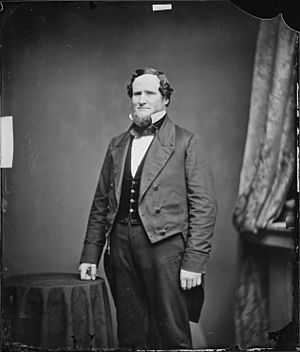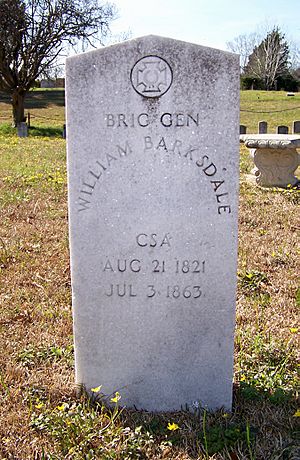William Barksdale facts for kids
Quick facts for kids
William Barksdale
|
|
|---|---|
 |
|
| Member of the U.S. House of Representatives from Mississippi's 3rd district |
|
| In office March 4, 1855 – January 21, 1861 |
|
| Preceded by | Otho R. Singleton |
| Succeeded by | Henry Barry |
| Member of the U.S. House of Representatives from Mississippi's at-large district |
|
| In office March 4, 1853 – March 3, 1855 |
|
| Preceded by | no at-large seats |
| Succeeded by | 3rd Congressional District established |
| Personal details | |
| Born | August 21, 1821 Smyrna, Tennessee |
| Died | July 3, 1863 (aged 41) Gettysburg, Pennsylvania |
| Resting place | Greenwood Cemetery Jackson, Mississippi |
| Political party | Democratic |
| Profession | Newspaper editor, soldier |
| Military service | |
| Allegiance | |
| Branch/service | |
| Years of service | 1847–1848 (USA) 1861–1863 (CSA) |
| Rank | |
| Unit | 2nd Mississippi Infantry (USA) |
| Commands | 13th Mississippi Infantry (CSA) Barksdale's Mississippi Brigade |
| Battles/wars | Mexican–American War American Civil War |
William Barksdale (born August 21, 1821 – died July 3, 1863) was an important figure in American history. He worked as a lawyer and a newspaper editor. He also served as a US Representative in Congress. Later, he became a general in the Confederate Army during the American Civil War. He was strongly in favor of states leaving the Union. Barksdale was badly wounded while leading his troops at the Battle of Gettysburg. He died shortly after this famous battle.
Contents
Early Life and Career
William Barksdale was born in Smyrna, Tennessee. His parents were William and Nancy Barksdale. He had an older brother, Ethelbert Barksdale. Ethelbert also served in the US Congress and later in the Confederate Congress. Their family came from England in the 1600s.
William Barksdale went to the University of Nashville. He started practicing law in Mississippi when he was 21. However, he soon decided to become a newspaper editor. He edited the Columbus [Mississippi] Democrat, a newspaper that supported slavery.
Barksdale joined the 2nd Mississippi Infantry Regiment. He served as a captain and quartermaster in the Mexican–American War. A quartermaster helps supply the army. Even so, he often joined in the fighting with the infantry.
After the war, Barksdale became a member of the United States House of Representatives. He was known nationally as a strong supporter of States' rights. He served in Congress from 1853 to 1861. He was known as one of the "Fire-Eaters" in the House. These were politicians who strongly supported states' rights and slavery.
In 1858, Barksdale was involved in a funny incident. A fight broke out between lawmakers who supported and opposed slavery. Barksdale swung at one congressman. Another congressman grabbed Barksdale, knocking off his wig. Barksdale put his wig back on backwards. This made everyone laugh and stopped the fight.
A Leader in the Civil War
When Mississippi left the Union, Barksdale resigned from Congress. He became an adjutant general for the Mississippi Militia. This meant he helped organize the state's military. He was promoted to brigadier general in March 1861.
In May 1861, he became a colonel in the Confederate States Army. He led the 13th Mississippi Infantry regiment. He led his troops in the First Battle of Bull Run that summer. They also fought in the Battle of Ball's Bluff in October.
The next spring, his regiment went to the Virginia Peninsula. They fought in the Peninsula Campaign and the Seven Days Battles. During the Battle of Savage's Station, his commander was badly wounded. Barksdale took command of the brigade. He led them in a brave but difficult charge at the Battle of Malvern Hill. His group became known as "Barksdale's Mississippi Brigade." He was promoted to brigadier general in August 1862.
During the Maryland Campaign, Barksdale's brigade was part of a larger division. They helped attack Maryland Heights. This led to the surrender of the Union soldiers at Harpers Ferry. At the Battle of Antietam, his division defended the West Woods. Their actions helped save the Confederate left side.

At the Battle of Fredericksburg, Barksdale's Brigade defended the city's waterfront. They shot at Union soldiers trying to cross the Rappahannock River. They used buildings that had been destroyed by Union artillery for cover.
In May 1863, at the Battle of Chancellorsville, Barksdale's brigade was one of the few units present. Most of their corps was elsewhere. Again, Barksdale's brigade defended the heights above Fredericksburg. They faced a Union force much larger than their own. Barksdale's men had to retreat after delaying the Union army. However, he was able to gather his brigade and retake the lost ground the next day.
The Battle of Gettysburg
Barksdale's Brigade arrived at the Battle of Gettysburg on July 1, 1863. General Robert E. Lee planned for their corps to attack the Union left side. Barksdale's attack would be at the "Peach Orchard." This area was a key part of the Union line.
Around 5:30 p.m., Barksdale's Brigade charged out of the woods. Their attack was very powerful. One Union officer called it "the grandest charge that was ever made by mortal man." Barksdale rode on horseback in front of his troops. He had his hat off, and his hair shone.
The Confederates broke through the Union line at the Peach Orchard. Some of Barksdale's regiments turned north and broke another Union division. Others went straight ahead. They reached Plum Run, about a mile into their attack. There, they were counterattacked by Union soldiers.
Barksdale was wounded in his left knee. Then, a cannonball hit his left foot. Finally, another bullet hit his chest, knocking him off his horse. He told his aide, "I am killed! Tell my wife and children that I died fighting at my post." His troops had to leave him behind. He died the next morning in a Union field hospital.
Barksdale was buried in the Barksdale family plot. This is in Greenwood Cemetery in Jackson, Mississippi. There is no marker on his grave. However, he has memorial stones in both Greenwood Cemetery and Friendship Cemetery in Columbus, Mississippi.
In Popular Media
William Barksdale has been shown in movies about the Civil War.
- He is played by Lester Kinsolving in the film Gettysburg.
- He also appears in the movie Gods and Generals, which is a story before Gettysburg.
- Barksdale is featured in the 2011 History Channel film Gettysburg.
A street in Leesburg, Virginia, is named Barksdale Drive. It is named after Colonel Barksdale. This street is a main road in the neighborhood.
See also
 In Spanish: William Barksdale para niños
In Spanish: William Barksdale para niños

